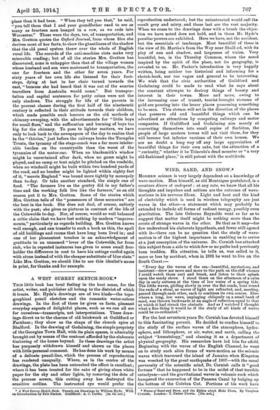A WEST SURREY SKETCH-BOOK.*
THIS little book hart-local feeling-hr-the best sense, for the artist, writer, and publisher all belong to the district of which it treats. Mr. Hyde's drawings are of two kinds—the topo- graphical pencil sketches and the romantic water-colour drawings. In the first of these he gives us facts, pleasant everyday aspects of delightful places, such as we can all see for ourselves—transcripts; not interpretations. These draw- ings direct us to the charms of old brickwork at Guildford or Farnham; they show us the shape of the church spire at Shalford. In the drawing of Godalming, the simple propriety of the Georgian Town Hall, with its plain spaces, is admirably brought out by means of the contrast afforded by the elaborate timbering of the house beyond. In these drawings the artist has purposely withdrawn himself and shown us the places with little personal comment. He has done his work by means of a delicate pencil-line, which the process of reproduction has rendered unequally. Where, as in the centre of the drawings, the plate has been untouched the effect is excellent; where it has been treated for the sake of giving clean white paper for the sky and other lights, by removing the dots of the process screen, this cutting away has destroyed the sensitive outline. The instructed eye would prefer the • d Wert Surrey Sketch-Book. Twenty-Mr Drawings by William Hyde. With an Introduction by Erie Parker. Guildford: A. C. Curtis. [4m 6d. net.] reproduction nndoctored; but the uninstructed would call the result grey and misty, and these last are the vast majority. When we come to the drawings done with a brush the objec- tion we have noted does not hold, and in these Mr. Hyde's peculiar powers are exhibited. Here we have, not the accident, but the essentials of landscape. Most beautiful of these is the view of St. Martha's from the Wey near Shalford, with its play of sun and shadow, and largeness of vision. Very beautiful, too, is the Thursley Common, where the mood inspired by the spirit of the place, not its geography, is revealed to us. Mr. Parker's introduction is very happily written, being neither too historical and informing for a sketch-book, nor too vague and general to be interesting. We wish that the civic authorities of Guildford and Godalming could be made to read what he says about the constant attempts to destroy things of beauty and interest in their towns. More and more, owing to the increasing ease of transit, tourist-brought streams of gold are pouring into the lesser places possessing something to be seen. This stream will set in the direction of the places that preserve old and beautiful things which can be advertised as attractions by competing railways and motor companies. If Guildford and Godalming aim merely at converting themselves into small copies of Surbiton, the people of large modern towns will not visit them, for they will become but inferior versions of their own homes. We are no doubt a long way off any large appreciation of beautiful things for their own sake, but the attraction of a " curiosity," whether it be Trinculo's dead monster or " a very old-fashioned place," is still potent with the multitude.


























































 Previous page
Previous page